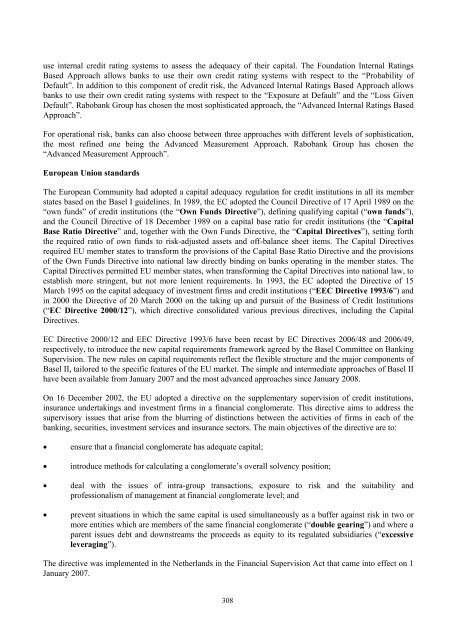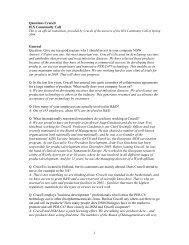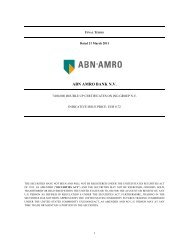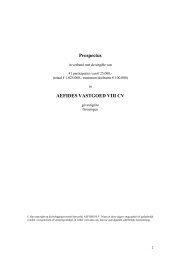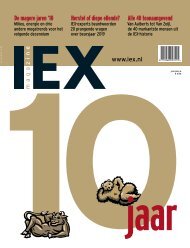Dit prospectus is gemaakt voor de uitgifte van dit product en ... - Iex
Dit prospectus is gemaakt voor de uitgifte van dit product en ... - Iex
Dit prospectus is gemaakt voor de uitgifte van dit product en ... - Iex
Create successful ePaper yourself
Turn your PDF publications into a flip-book with our unique Google optimized e-Paper software.
use internal cre<strong>dit</strong> rating systems to assess the a<strong>de</strong>quacy of their capital. The Foundation Internal RatingsBased Approach allows banks to use their own cre<strong>dit</strong> rating systems with respect to the “Probability ofDefault”. In ad<strong>dit</strong>ion to th<strong>is</strong> compon<strong>en</strong>t of cre<strong>dit</strong> r<strong>is</strong>k, the Ad<strong>van</strong>ced Internal Ratings Based Approach allowsbanks to use their own cre<strong>dit</strong> rating systems with respect to the “Exposure at Default” and the “Loss Giv<strong>en</strong>Default”. Rabobank Group has chos<strong>en</strong> the most soph<strong>is</strong>ticated approach, the “Ad<strong>van</strong>ced Internal Ratings BasedApproach”.For operational r<strong>is</strong>k, banks can also choose betwe<strong>en</strong> three approaches with differ<strong>en</strong>t levels of soph<strong>is</strong>tication,the most refined one being the Ad<strong>van</strong>ced Measurem<strong>en</strong>t Approach. Rabobank Group has chos<strong>en</strong> the“Ad<strong>van</strong>ced Measurem<strong>en</strong>t Approach”.European Union standardsThe European Community had adopted a capital a<strong>de</strong>quacy regulation for cre<strong>dit</strong> institutions in all its memberstates based on the Basel I gui<strong>de</strong>lines. In 1989, the EC adopted the Council Directive of 17 April 1989 on the“own funds” of cre<strong>dit</strong> institutions (the “Own Funds Directive”), <strong>de</strong>fining qualifying capital (“own funds”),and the Council Directive of 18 December 1989 on a capital base ratio for cre<strong>dit</strong> institutions (the “CapitalBase Ratio Directive” and, together with the Own Funds Directive, the “Capital Directives”), setting forththe required ratio of own funds to r<strong>is</strong>k-adjusted assets and off-balance sheet items. The Capital Directivesrequired EU member states to transform the prov<strong>is</strong>ions of the Capital Base Ratio Directive and the prov<strong>is</strong>ionsof the Own Funds Directive into national law directly binding on banks operating in the member states. TheCapital Directives permitted EU member states, wh<strong>en</strong> transforming the Capital Directives into national law, toestabl<strong>is</strong>h more string<strong>en</strong>t, but not more l<strong>en</strong>i<strong>en</strong>t requirem<strong>en</strong>ts. In 1993, the EC adopted the Directive of 15March 1995 on the capital a<strong>de</strong>quacy of investm<strong>en</strong>t firms and cre<strong>dit</strong> institutions (“EEC Directive 1993/6”) andin 2000 the Directive of 20 March 2000 on the taking up and pursuit of the Business of Cre<strong>dit</strong> Institutions(“EC Directive 2000/12”), which directive consolidated various previous directives, including the CapitalDirectives.EC Directive 2000/12 and EEC Directive 1993/6 have be<strong>en</strong> recast by EC Directives 2006/48 and 2006/49,respectively, to introduce the new capital requirem<strong>en</strong>ts framework agreed by the Basel Committee on BankingSuperv<strong>is</strong>ion. The new rules on capital requirem<strong>en</strong>ts reflect the flexible structure and the major compon<strong>en</strong>ts ofBasel II, tailored to the specific features of the EU market. The simple and intermediate approaches of Basel IIhave be<strong>en</strong> available from January 2007 and the most ad<strong>van</strong>ced approaches since January 2008.On 16 December 2002, the EU adopted a directive on the supplem<strong>en</strong>tary superv<strong>is</strong>ion of cre<strong>dit</strong> institutions,insurance un<strong>de</strong>rtakings and investm<strong>en</strong>t firms in a financial conglomerate. Th<strong>is</strong> directive aims to address thesuperv<strong>is</strong>ory <strong>is</strong>sues that ar<strong>is</strong>e from the blurring of d<strong>is</strong>tinctions betwe<strong>en</strong> the activities of firms in each of thebanking, securities, investm<strong>en</strong>t services and insurance sectors. The main objectives of the directive are to:• <strong>en</strong>sure that a financial conglomerate has a<strong>de</strong>quate capital;• introduce methods for calculating a conglomerate’s overall solv<strong>en</strong>cy position;• <strong>de</strong>al with the <strong>is</strong>sues of intra-group transactions, exposure to r<strong>is</strong>k and the suitability andprofessional<strong>is</strong>m of managem<strong>en</strong>t at financial conglomerate level; and• prev<strong>en</strong>t situations in which the same capital <strong>is</strong> used simultaneously as a buffer against r<strong>is</strong>k in two ormore <strong>en</strong>tities which are members of the same financial conglomerate (“double gearing”) and where apar<strong>en</strong>t <strong>is</strong>sues <strong>de</strong>bt and downstreams the proceeds as equity to its regulated subsidiaries (“excessiveleveraging”).The directive was implem<strong>en</strong>ted in the Netherlands in the Financial Superv<strong>is</strong>ion Act that came into effect on 1January 2007.308


